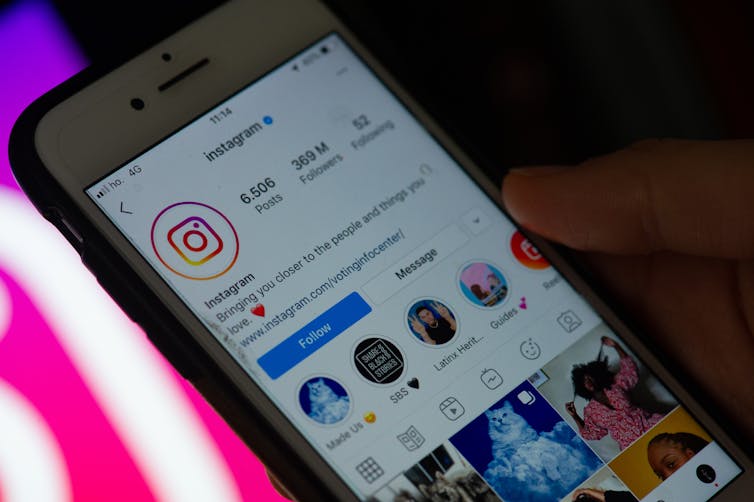Instagram's redesign shifts toward shopping – here's how that can be harmful
Instagram's Shop button signals the growing commodification of human interactions on social media.

Recently, when I opened Instagram, I noticed that the usual spot for checking notifications is now a Shop tab. The Instagram blog post announcing the redesign said that the change will support small businesses and connect people with their favorite brands and creators.
This made me pause. As a researcher who studies social media, people and society, I’m concerned about the effects of surveillance capitalism. This includes social media companies profiting from collecting user data, making algorithmic inferences about people’s preferences and using this information to target people with advertising.
Features like Instagram’s Shop tab facilitate surveillance capitalism, so it’s important to look at their consequences. Many people use Instagram to share their lives with other people, but the redesign is shifting the nature of the social media platform toward online commerce. This shift opens people to highly targeted advertising and makes them vulnerable to advertising that exploits their emotional experiences.
Shift to shopping
Research, including my own, shows that people use Instagram to record their big and mundane moments, find community, exchange social support, express identities and keep in touch with friends.
In 2017, colleagues and I showed how ad hoc communities form around the tag #depression on the platform, and how much of the discourse is to make sense of the experience of depression, record it, share it with others and exchange support with other people dealing with depression. I argued that it is important for the platform to recognize the value users find in these communities and support them, rather than ban or nudge them to go elsewhere, when they come to the platform to express themselves and build solidarity.
The notification button, represented as a heart icon, brings up a screen that indicates the interactions people have had with your Instagram presence – for example, who has liked your posts and comments. It’s likely that the notification button was the most frequently clicked tab. When people interact with technology, they form habits. I am probably not the only one clicking the new Shop tab when I mean to click the notification button. It’s possible that the company did this simply to ensure that Instagram users encounter the new feature, but there are other ways to accomplish that.

By choosing to make the Shop tab central to its platform, Instagram is sending its users a message: This platform is a business, and interactions on this platform are going to be commodified.
Though some people may come to Instagram to find things to buy, many don’t. App designers can provide an unneeded feature and create a need for it over time. This is not without precedence in the context of social media and shopping. For example, when Facebook, which owns Instagram, relaunched Facebook Marketplace in 2016, the Marketplace product manager, Bowen Pan, said: “We show you the most relevant items for you, even if you don’t know what you want.”
Potential harms
People share all kinds of personal information on Instagram, such as mental health, physical health, traumatic events, pregnancy, loss, infertility, becoming new parents and getting married. Social media companies’ access to such sensitive information is a concern, for how the companies could exploit the information and the risk of third-party access to the data.
Instagram can use computational techniques to infer people’s affective states – their emotions and moods – based on many signals available to the platform. These include what content users view and post. There is substantial evidence that emotions and affective states play a key role in advertising. While capitalizing on emotions and emotional personal experiences for profit is not unique to social media or algorithms, the data-driven, opaque and hyperpersonalized approaches boost the scale of potential harm.
Presumably, what people see in Instagram’s Shop is personalized based on what the platform’s recommendation algorithm determines they would like and be inclined to purchase. How does the inferred socioeconomic, gender, age, race and other attributes shape what the platform recommends to users in the Shop tab? What shops get to be recommended and visible? Instagram users can be as young as 13, the age required to open an account. How does personalization work for children? How does this feature affect the experience of individuals with low socioeconomic status? What principles and values is the platform adhering to in designing these recommendation algorithms, Staff Picks and other means of presenting products?
A major consideration is when people get recommendations to purchase items during vulnerable moments. Sharing or seeking information about a difficult, personal experience on a social media platform and then having the platform capitalize on an algorithmic understanding of the experience – which might or might not be accurate – is problematic.
What are the implications for impulsive buyers who may turn to Instagram as a space for community and peer support to resist impulsive purchasing, but who are instead confronted with things to purchase and have no way of opting out? How about for someone who is on the platform to find support while coping with a substance use disorder, but instead encounters recommendations to purchase items related to drinking? What happens if a person posting about experiences with pregnancy loss begins seeing ads for baby clothes? This last scenario has happened.
In recent and upcoming studies, I observed that, to varying degrees, people find social media platforms capitalizing on their personal, intimate experiences – especially those associated with negative emotions – manipulative and harmful. Social media platform designers and decision-makers should consider ways to address potential harms preemptively rather than retroactively.
The Instagram blog post announcing the Shop feature states that there are marketers and influencers on the platform and young people who want to purchase the same products their favorite creators use. This might be a need for some Instagram users, but not all. If Instagram is determined to emphasize shopping, and if opting in is not possible, I believe the company should allow users to opt out of the Shop feature.
Losing personal connections
Recent research has shown that people share less and less personal information on Facebook, which has had its Marketplace feature since 2016, and use platforms like Instagram to engage in more personal, intimate discourse. This is due in part to site features and whom people are connected to on each platform. By moving away from a focus on people and their connections, and by commodifying and potentially manipulating users to purchase items on the platform, Instagram could go down the road that Facebook did – fewer personal connections and less personal, meaningful content.
Instagram’s website states that it is “bringing you closer to the people and things you love.” But people and things are different phenomena, and the ways people feel closer to each other are different from the ways they are drawn to things, businesses and brands. By wanting to do both, or perhaps by using the former to benefit the latter, the company may be missing the mark on how to bring people closer together.
[You’re smart and curious about the world. So are The Conversation’s authors and editors. You can get our highlights each weekend.]
Nazanin Andalibi does not work for, consult, own shares in or receive funding from any company or organization that would benefit from this article, and has disclosed no relevant affiliations beyond their academic appointment.
Read These Next
Christmas trees are more expensive than ever in Colorado — what gives?
Most Christmas trees are imported from other states, which drives up costs.
From civil disobedience to networked whistleblowing: What national security truth-tellers reveal in
Whistleblowers’ stories show how accountability is shifting from formal legal institutions to solidarity…
2025’s extreme weather had the jet stream’s fingerprints all over it, from flash floods to hurricane
The US had a rare year without a hurricane make landfall, but it saw too much extreme rainfall and flash…






